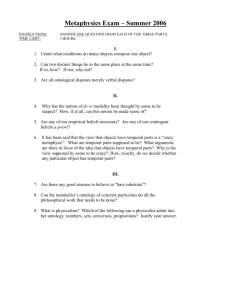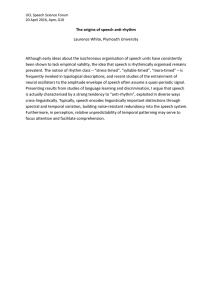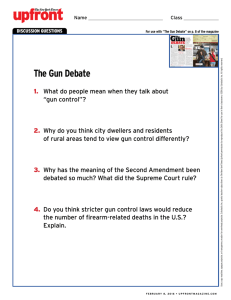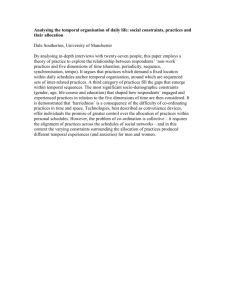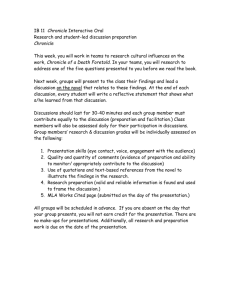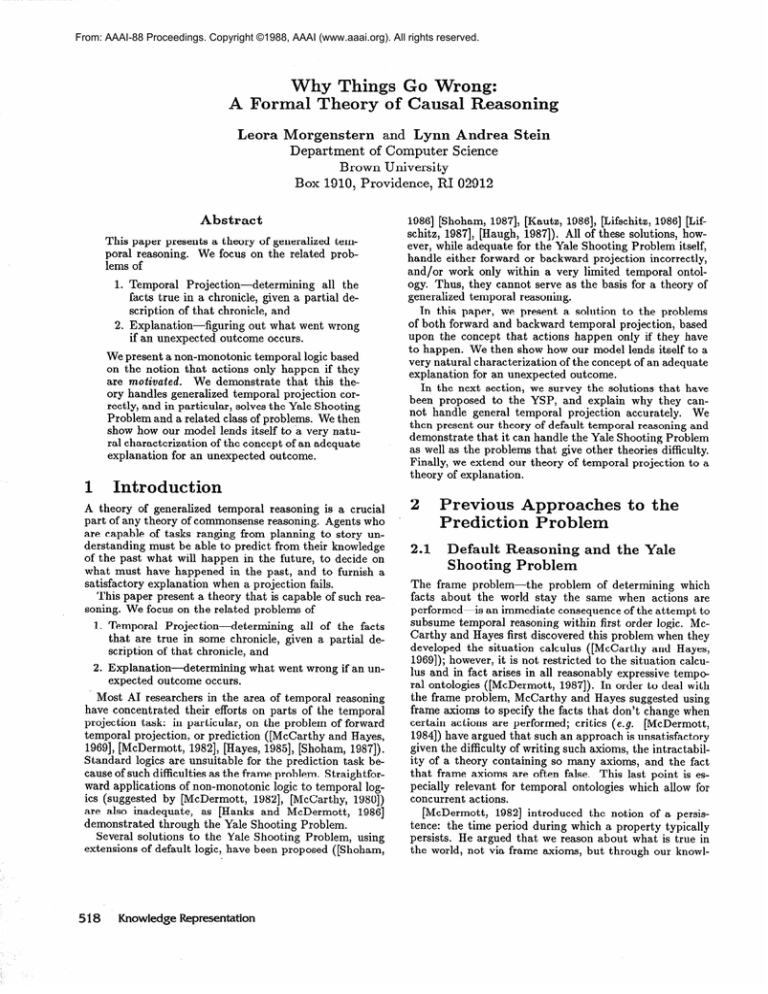
From: AAAI-88 Proceedings. Copyright ©1988, AAAI (www.aaai.org). All rights reserved.
Why Things Go Wrong:
A Formal Theory of Causal Reasoning
Leora
Morgenstern
and Lynn Andrea
Department of Computer Science
Brown University
Box 1910, Providence, RI 02912
Abstract
This paper presents a theory of generalized temporal reasoning. We focus on the related problems of
1. Temporal Projection-determining
all the
facts true in a chronicle, given a partial description of that chronicle, and
2. Explanation-figuring
out what went wrong
if an unexpected outcome occurs.
We present a non-monotonic temporal logic based
on the notion that actions only happen if they
are motivated. We demonstrate that this theory handles generalized temporal projection correctly, and in particular, solves the Yale Shooting
Problem and a related class of problems. We then
show how our model lends itself to a very natural characterization of the concept of an adequate
explanation for an unexpected outcome.
1
19861 [Shoham, 19871, [Kautz, 19861, [Lifschitz, 19861 [Lifschitz, 19871, [Haugh, 19871). All of these solutions, however, while adequate for the Yale Shooting Problem itself,
handle either forward or backward projection incorrectly,
and/or work only within a very limited temporal ontology. Thus, they cannot serve as the basis for a theory of
generalized temporal reasoning.
In this paper, we present a solution to the problems
of both forward and backward temporal projection, based
upon the concept that actions happen only if they have
to happen. We then show how our model lends itself to a
very natural characterization of the concept of an adequate
explanation for an unexpected outcome.
In the next section, we survey the solutions that have
been proposed to the YSP, and explain why they cannot handle general temporal projection accurately. We
then present our theory of default temporal reasoning and
demonstrate that it can handle the Yale Shooting Problem
as well as the problems that give other theories difficulty.
Finally, we extend our theory of temporal projection to a
theory of explanation.
Introduction
A theory of generalized temporal reasoning is a crucial
part of any theory of commonsense reasoning. Agents who
are capable of tasks ranging from planning to story understanding must be able to predict from their knowledge
of the past what will happen in the future, to decide on
what must have happened in the past, and to furnish a
satisfactory explanation when a projection fails.
This paper present a theory that is capable of such reasoning. We focus on the related problems of
1. Temporal Projection-determining
all of the facts
that are true in some chronicle, given a partial description of that chronicle, and
2. Explanation-determining
expected outcome occurs.
what went wrong if an un-
Most AI researchers in the area of temporal reasoning
have concentrated their efforts on parts of the temporal
projection task: in particular, on the problem of forward
temporal projection, or prediction ([McCarthy and Hayes,
19691, [McDermott, 19821, [Hayes, 19851, [Shoham, 19871).
Standard logics are unsuitable for the prediction task because of such difficulties as the frame problem. Straightforward applications of non-monotonic logic to temporal logits (suggested by [McDermott, 19821, [McCarthy, 19801)
are also inadequate, as [Hanks and McDermott, 19861
demonstrated through the Yale Shooting Problem.
Several solutions to the Yale Shooting Problem, using
extensions of default logic, have been proposed ([Shoham,
518
Knowledge Representation
Stein
2
Previous Approaches
Prediction
Problem
2.31 Default
Shooting
Reasoning
Problem
to the
and the Yale
The frame problem-the
problem of determining which
facts about the world stay the same when actions are
performed-is an immediate consequence of the attempt to
subsume temporal reasoning within first order logic. McCarthy and Hayes first discovered this problem when they
developed the situation calculus ([McCarthy and Hayes,
19691); however, it is not restricted to the situation calculus and in fact arises in all reasonably expressive temporal ontologies ([McDermott, 19871). In order to deal with
the frame problem, McCarthy and Hayes suggested using
frame axioms to specify the facts that don’t change when
certain actions are performed; critics (e.g. [McDermott,
19841) have argued that such an approach is unsatisfactory
given the difficulty of writing such axioms, the intractability of a theory containing so many axioms, and the fact
that frame axioms are often false. This last point is especially relevant for temporal ontologies which allow for
concurrent actions.
[McDermott, 19821 introduced the notion of a persistence: the time period during which a property typically
persists. He argued that we reason about what is true in
the world, not via frame axioms, but through our knowl-
edge of the persistences of various properties. Such reasoning is inherently non-monotonic.
These considerations led [McDermott, 19821 to argue
that temporal reasoning is best formalized within a nonmonotonic logic. The discovery of the Yale Shooting Problem ([Hanks and McDermott, 1986]), however, demonstrated that this might not always yield desirable results.
The Yale Shooting Problem can briefly be described as
follows: Assume that a gun is loaded at time 1, and the
gun is fired (at Fred) at time 5. We know that if one loads
a gun at time j, it is loaded at time j+ll that if a loaded
gun is fired at a person at time j, the person is dead at time
j+l, that if a gun is loaded at j, it will typically be loaded
at time j+l (“loaded” persists for as long as possible), and
that if a person is alive at time j, he will typically be alive
at time j+l (“alive” persists for as long as possible).
We would like to predict that Fred is dead at time 6. Relative to standard non-monotonic logics ([McDermott and
Doyle, 19801, [McCarthy, 19801, [Reiter, 1980]), however,
the chronicle description supports (at least) two models:
the expected one, in which one reasons by default that the
gun is loaded at time 5, and in which Fred is dead at time 6,
and the unexpected model in which one reasons by default
that Fred is alive at time 6, and in which, therefore, the
gun must be unloaded at time 5. Standard non-monotonic
logic gives us no way of preferring the expected, intuitively
correct model to the unexpected model.
Like the frame problem, the Yale Shooting Problem was
first presented within the situation calculus framework, but
is not restricted to that particular ontology ([McDermott,
19871).
2.2
Proposed
Solutions
Their Limitations
to the YSP
and
In their original discussion of the Yale Shooting Problem,
Hanks and McDermott argued that the second, unexpected
model seems incorrect because we tend to reason forward
in time and not backward. The second model seems to
reflect what happens when we reason backward. Such reasoning, they argued, is unnatural: the problem with nonmonotonic logic is that there is no way of preferring the
forward reasoning models to the backward reasoning models.
2.2.1
Chronological
Minimization
The first wave of solutions to the Yale Shooting Problem
([Shoham, 19861, [Kautz, 19861, [Lifschitz, 19861) all independently set out to prove that such a preference could
indeed be expressed in non-monotonic logic. We discuss
Shoham’s work here: criticisms of his theory apply equally
to the others in the group.
Shoham defines the following preference relation on
models: Ml is preferable to M2 if Ml and Mz agree
up to some time point j, but at j, there is some fact known
to be true in Mz, which is not known to be true in Ml.
Ml is said to be chronologically more ignorant than Mz.
This preference defines a partial order; models which are
minimal elements under this ordering are said to be chronologically maximally ignorant.
‘It is implicitly a ssumed that actions take unit time.
The expected model-in
which Fred is dead-is preferable to the unexpected model-in
which Fred is alive,
since, in the unexpected model, it would be known that
at some point before 5, something happened to unload the
gun.
In fact, in all chronologically maximally ignorant
models for this set of axioms, the gun is loaded at time 5,
and therefore, Fred is dead.
Solutions based upon forward reasoning strategies have
two drawbacks. In the first place, agents perform both
backward and forward reasoning. In fact, agents typically
do backward reasoning when performing backward temporal projection. Consider, for example, a modification of the
Yale Shooting Problem, where we are told that Fred is alive
at time 6. We should know that the gun must somehow
have become unloaded between times 2 and 5; however,
we should not be able to say exactly when this happened.
In contrast to this intuition, the systems of Shoham and
Kautz would predict that the gun became unloaded between time 4 and time 5. This is because things stay the
same for as long as possible.2
A second objection to the strategy of chronological minimization is that it does not seem to address the real concerns underlying the Yale Shooting Problem. We don’t
reason that Fred is dead at time 6 because we reason forward in time. We conclude that Fred is dead because we
are told of an action that causes Fred’s death, but are not
told of any action that causes the gun to be unloaded.
2.2.2
Circumscribing
Over
Causes
[Lifschitz, 19871 and [Haugh, 19871 independently proposed solutions which were not based upon forward reasoning strategies. We present Lifschitz’s; again criticisms
of his theory apply to both. Lifschitz’s solution is based
on the intuition that “all changes in the values of fluents are caused by actions.” Lifschitz introduces a predicate causes(act,f,v), where action act causes fluent f to
take on value v, and a predicate precond(f,act). Success
is defined in terms of precond, affects in terms of causes
and success. He circumscribes over both the causes and
precond predicates; circumscribing over causes solves the
frame problem. 3 Things are only caused when there are
axioms implying that they are caused. Necessary preconditions for an action are satisfied only when the axioms force this to be the case. Actions are successful exactly when all preconditions hold; actions affect the values of fluents if and only if some successful action causes
the value to change. Assuming, now, the following axioms: causes(load,loaded,true), causes(shoot,loaded,false),
causes(shoot,alive,false),
precond(loaded,shoot),
and a
chronicle description stating that a load takes place at 1,
a wait at 2,3, and 4, and a shoot at 5, we can predict that
Fred is dead at time 6. There is no way that the wait action
can cause the fluent loaded to take on the value false.
This solution doesn’t force reasoning to go forward in
time. Nevertheless,
Lifschitz’s solution is highly problematic.
It works only within rigid formalisms
like the situation calculus, and cannot be extended to-and
in fact
yields incorrect results in-a
more flexible, realistic theory.
2This point was noted by Kautz when he first presented his
solution to the Yale Shooting Problem.
3Li&chitz introduces the precond predicate in order to solve
the qualification problem, which we don’t discuss here.
Morgenstem and Stein
519
ivloreover, a closer exammaclon OI tne solution shows that
it does not address one of the major intuitions underlying
the Yale Shooting Problem.
It is crucial to realize that the causes predicate over
which Lifschitz circumscribes ranges over action types as
opposed to action instances. Circumscribing over causes
thus entails that state changes will not happen spontaneously, but does not in general entail that as little will
change as possible. Since the situation calculus framework
itself entails that as little as possible happens, the solution
will work as long as we stay within this rigid framework.
Problems arise, however, in frameworks in which not all
actions are known.
Consider what would happen in a world in which concurrent actions were allowed, and in which we were to add
the rule causes(unload,loaded,false) to the theory. We could
, then have a model Ml where an unload occurs at time 2,
the gun is thus unloaded, and Fred is alive at time 6. There
would be no way to prefer the expected model where Fred
dies to this model.4 This cannot in fact happen in Lifschitz’s formulation because in the situation calculus, concurrent actions aren’t allowed. Since a wait action occurs
at times 2, 3, and 4, nothing else can occur, and unload
actions are ruled out.
Lifschitz’s solution thus works only in frameworks where
all the acts in a chronicle are known. In these cases, circumscribing the cause predicate gives us exactly what we
want-it disables spontaneous state changes. The intuition
underlying the Yale Shooting Problem, however, is that we
can make reasonable temporal projections in worlds where
concurrent actions are allowed, even if we aren’t necessarily told of all the events that take place in a chronicle. The
fact is that even if we are given a partial description, we
will generally not posit additional actions unless there is a
good reason to do so.
The temporal projection problem is thus a dual one: we
must reason that actions don’t cause fluents to take on
values in unexpected ways, and we must reason that unexpected events don’t in general happen. Lifschitz solved
the first of these problems; in the next section, we turn our
attention to the second.
3
Temporal
Projection:
Theory of Motivated
A
Actions
In this section, we develop a model of temporal projection which yields a satisfying solution to the Yale Shooting Problem, and which lends itself nicely to a theory of
4Haugh seems to address a related point in his paper. Haugh
considers the case where we have an axiom stating that unload
causes loaded to‘be false, and that the precondition
for unload is
that the performing agent knows how to perform the action (we
recast into Lifschitz’s formalism here for ease of comparison).
Then, if it is known that an unload(attempt) Occurs, there will
be no way of preferring models where loaded is true to models
where loaded is false. Haugh says that this is to be expected;
if we know of an unload attempt, we do not want to conclude
that loaded is true. This argument is really beside the point. It
is quite clear that if we are told of an unload (attempt), we will
not conclude that Fred is dead. The point of the YSP is that,
if you are not explicitly- told of an unload, you will not seriously
consider the possibility when making a prediction.
520
Knowledge
Representation
explanation. Our model formalizes the intuition that we
typically reason that events in a chronicle happen only
when they “have to happen”. We formalize the idea of a
motivated action, an action that must occur in a particular
model.
3.1
The
Formal
Theory
We begin by formally describing the concepts of a theory
and a chronicle description. We work in a first order logic
L, augmented by a simple temporal logic. Sentences are
of the form True(j,f) w h ere t is a time point, and f is a
fluent-a
term representing some property that changes
with time. True(j,+)
iff lTrue(j,f).
Occurs(act) and loaded
are examples of fluents. If cp = True(j,f), j is referred to
as the time point of 9, time(p). Time is isomorphic to the
integers. Actions are assumed to take unit time.
A theory, T, and a chronicle description,
CD, are sets
of sentences of L. The union of a theory and a chronicle
description is known as a theory instantiation,
TI. Intuitively, a theory contains the general rules governing the
behavior of (some aspects of) the world; a chronicle description describes some of the facts that are true in a
particular chronicle. A theory includes cuusaZ rules and
persistence
rules. A causal rule is a sentence of the form
QA p _
y, where:
cy is
a non-empty
set
True(j,Occurs(act))-th
causal rule,
of sentences of the form
e set of triggering events of the
fl is a conjunction of statements stating the preconditions
of the action, and
y describes the results of the action.
that y can include sentences of the form
True(j+l,Occurs(act)).
W e can thus express causal chains
of action.
A persistence rule is of the form
Note
True(j,p)~p =+ True(j+l,p)
where p includes a conjunction of statements of the form
True(j,lOccurs(act))
These persistence rules bear a strong resemblance to frame
axioms. In reality, however, they are simply instances of
the principle of inertia: things do not change unless they
have to.
We have hand coded the persistence rules for this simple
case, although it is not necessary to do so. They can in fact
be automatically generated from the theory’s causal rules,
relative to a closed world assumption on causal rules: that
all the causal rules that are true are in the theory. This is
indeed exactly what Lifschitz achieves by circumscribing
over the causes predicate in his formulation. It is likely
that such a strategy will be an integral part of any fully
developed
theory of temporal
matic generation of persistence
projection.
Since the autorules is not the main thrust
of this paper, we will not develop this here.
It is important to note that all of the rules in any theory T are monotonic. We achieve non-monotonicity solely
by introducing
a preference criterion on models:
in partitular, preferring models in which the fewest possible extraneous actions occur.
Typically,
we will not be given
enough information in a particular chronicle description
to determine whether or not the rules in the theory fire.
However, because persistence rules explicitly refer to the
non-occurrence of events, and because we prefer models
in which events don’t occur unless they have to, we will
in general prefer models in which the persistence rules do
fire. The facts triggered by persistence rules will often allow causal rules to fire as well.
3.2
Motivated
Actions
Given a particular theory instantiation, we would like to be
able to reason about the facts which ought to follow from
the chronicle description under the theory. In particular,
we would like to be able to determine whether a statement
of the form True(j,p) is true in the chronicle. If j is later
than the latest time point mentioned in CD, we call this
reasoning prediction, or forward projection, otherwise, the
reasoning is known as backward projection.
Given TI= TlJ CD, we are thus interested in determining the preferred models for 2’1. M(TI) denotes a model
for TT: i.e., (VP E T.Z)[M(TI)
+ cp]. We define a preference criterion for models in terms of motivated actions:
those actions which “have to happen.”
Our strategy will
be to minimize those actions which are not motivated.
Definition:
Given a theory instantiation TI = T U CD,
we say that a statement cp is motivated in M(TI_) if it
is strongly motivated in M(TI)
or weakly motivated
in M(TI).
A statement cp is strongly motivated with respect to TI
if cp is in all models of TI, i.e. if (VM(TI))[M(TI)
b
cp]. If cp is strongly motivated with respect to TI, we
say that it is motivated in M( TI), for all M( Tl).
A statement cp is weakly motivated in M(TI)
if there
exists in TI a causal or persistence rule of the form
cv A ,8 _
cp, Q is (strongly or weakly) motivated in
M(TI), and M(TI) I= P.
Intuitively, cp is motivated in a model if it has to be in
that model. Strong motivation gives us the facts we have
in CD to begin with as well as their closure under T. Weak
motivation gives us the facts that have to be in a particular
model relative to T. Weakly motivated facts give us the
non-monotonic part of our model-the
conclusions that
may later have to be retracted.
We now say that a model is preferred if it has as few
unmotivated actions as possible. Formally, we define the
preference relation on models as follows:
9
TI.
induces a partial ordering on acceptable models of
A model is preferred if it is a minimal element under
9:
M( T.2) is a preferred
model
a M(TZ) _
M’(TQ
w M(TI).
Definition:
M’(TI)
nM*
= {p 1 (VM E M*(TI))[M
b ‘p]}-the
ments true in all preferred models of TI
If both Mi(TI)
g Mj(TI)
and Mj(TI)
4 Mi(TI),
we say that Mi(T.2) and Mj(TI)
are e&ipreferabZe
(Mi(TI)
w Mj(TI))-
if
set of state-
b ‘p]}-the
set of state=
{‘p I(3M E M*(TI))[M
ments true in at least one preferred model of TI
uM*
Consider, now, the relationship between any statement
cp and TI. There are three cases:
Case k p
is in
projects
Case
cp is in UM*(TI).
II:
In this case, we say that cp is
not project cp.
with TI. However, TIdoes
consistent
Case
In this case, we say that TI
nM”(Tr).
cp.
III: p not in UM*(TI~.
In this case, we say that ‘p
is inconsistent
with TI. In fact, it is the case that TI
projects 19.
If TIprojects cp, and time(v) is later than the latest time
point mentioned in TI, we say that TI predicts cp.
3.3
Prediction:
The Yale Shooting
Problem,
Revisited
We now show that our theory can handle the Yale Shooting Problem. We represent the scenario with the following
theory instantiation:
CD:
True(l,alive)
True( 1,load)
True(5,shoot)
T contains the causal rules for shoot, load, and unload,
as well as the persistences for loaded and alive:
T:
Causal
Rules:
True(j,Occurs(load))
a
True(j,Occurs(shoot))
Let cp be of the form True(j,Occurs(act)).
is preferable
to Mj)
if
Mi(TI) 9 Mj(TI)
(Mi
(Vp)[Mi(TI)
b p A Mj(TI)
l;t cp _
p is motivated
in Mi(TI).
Definition:
TI
Since not all models are comparable under 9 , there
may be many preferred models. Let M*(TI) be the union
of all preferred models.
We define the following sets:
True(j,shoot)
True(j,unload)
Persistence
True(j+l,loaded)
A
Definition:
That is, Mi(TZ)
is preferable to Mj(T.2) if any action
which occurs in Mi( Tl) but does not occur in Mj( Tl) is
motivated in Mi(TI).
Note that such actions can only be
weakly motivated; if an action is strongly motivated, it is
true in all models.
for
True(j,loaded)
a
True(j+l,lalive)
)
True(j+l,+oaded)
=+
True(j+l,+oaded)
Rules:
True(j,alive)
A
(True(j,lOccurs(shoot))
V
_
True(j,loaded)
a
True(j,lloaded))
True(j+l,alive)
/\
True(j,lOccurs(shoot))
A
True(j,lOccurs(unload))
True(j+l,loaded)
Morgenstem and Stein
521
Let Ml be the expected model, where the gun is loaded
at 5, and Fred is dead at 6; and let MZ be the unexpected
model, where an unload takes place at some time between
2 and 5, and therefore Fred is alive at 6. Both Ml and
Ma are models for TI. However, we will see that Ml is
preferable to M 2, since extra, unmotivated actions take
place in Ma.
We
note that the facts True(l,alive), True(l,Occurs(load)), and
are strongly motivated, since they
True(5,0ccurs(shoot))
are in CD. The fact True(2,loaded) is also strongly motivated; it is not in CD, but it must be true in all models
of TI. In Ml, the model in which the gun is still loaded
at 5, True(G,-alive)
is weakly motivated. It is triggered by
the shoot action, which is motivated, and the fact that the
gun is loaded, which is true in Mr. In Ma, the occurrence
of the unload action is unmotivated. It is not triggered by
anything.
According to this definition, then, Ml is preferable to
M2. There is no action which occurs in Ml that does not
occur in Ma. However, M2 is not preferable to Ml: there
is an action, unload, which occurs in Ma, but not in Mr,
and this action is unmotivated.
In fact, it can be seen that in any preferred model of
TI, the gun must be loaded at time 5, and therefore Fred
must be dead at time 6. That is because in a model where
the gun is unloaded at 5, a shoot or unload action must
happen between times 2 and 5, and such an action would
be unmotivated. Since the facts that loaded is true at time
5 and that Fred is dead at time 6 are in all preferred models
of TI, TI projects these facts.
Note that preferring models in which the fewest possible
unmotivated actions occur is not equivalent to preferring
models in which the fewest possible actions occur. Consider , e.g., a theory of message passing in which messages
go through several checkpoints before completion.
The
message is passed as long as the control switch is open.
An action is needed to close the switch. If we know that
the message is started, we would like to predict that the
switch remains open and the message completes. This is
in fact what our preference criterion projects. However,
since each stage of the message passing can be regarded
as a separate action, a theory minimizing occurrences will
predict that the switch is turned off, eliminating additional
message passing segments.
3.4
Backward
Projection
We now show that our theory handles backward projection
properly. As an example, consider TI’, where Tl’ = TIu
{True(G,alive)).
Th a t is, Tl’ is the theory instantiation
resulting from adding the fact that Fred is alive at time
6 to the chronicle description of TI. Since we know that
a shoot occurred at 5, we know that the gun cannot have
been loaded at 5. However, we also know that the gun
was loaded at 2. Therefore, the gun must have become
unloaded between 2 and 5.5 Our theory tells us nothing
more than this. Consider the following acceptable models
5As we know, either an unload or a shoot will cause a gun
to be unloaded. However, because we know that shooting will
cause Fred to be dead, that dead persists forever, and that Fred
is alive at 6, all acceptable models for TI’ must have an unload.
522
Knowledge Representation
for Tl’:
0
where unload occurs at 2, the gun is unloaded at
3,4, and 5
M:,
@ M;, where unload occurs at 3, the gun is loaded at 3
and unloaded at 4 and 5
0
where unload occurs at 4, the gun is loaded at 3
and 4, and unloaded at 5.
J%
Intuitively, there does not seem to be a reason to prefer
one of these models to the other. And in fact, our theory
does not: Mi, ML, and M$ are equipreferable. Note,
however, that both M’, and M$ are preferable to Mi, the
model in which unload occurs at 2, load at 3, and unload at
4. Mi is acceptable, but has superfluous actions. In fact, it
can be shown that Mi, Mi, and M$ are preferred models
for TI’. All that TI’ can predict, then, is the disjunction:
True(2,0ccurs(unload))
V
True(3,0ccurs(unload))
V
True(4,Occurs(
unload))
which is exactly what we wish.
A theory of temporal reasoning that can handle both forward and backward projection properly is clearly a prerequisite for any theory of explanation. Now that we have
developed such a theory, we present a theory of explanation.
Intuitively, the need to explain something arises when
we are initially given some partial chronicle description
accompanied by some theory, we make some projections,
and then we subsequently discover these projections to be
false. When we find out the true story, we feel a need
to explain “what went wrong”-that
is, why the original
projections did not in fact hold true.
Formally, we can describe the situation as follows: Consider a theory instantiation TIl = TU CDi, with nM*tTI1)
equal to the set of facts projected by T1i. Consider now
a second theory instantiation TI2 = T U CDs, where
CD2 > CD1. That is, TIz is TIi with a more fleshed
out description of the chronicle. We say that there is a a
need for explanation of TI2 relative to TIl if there exists
some fact K E CD2 such that TIl does not project K, i.e.
if (3~ E CD,)[K ft nM*(,,.il)]. For any such K, we say that
K: must be explained relative to TIl and TI,.
The need for explanation may be more or less pressing
depending upon the particular situation. There are two
cases to be distinguished:
Case I :
n is not projected by TIl, i.e. K @ r-~~*(~~). However K is consistent with T.&, i.e. rc E UM*(TI1).
That
is, K is true in some of the preferred models of 271,
it just is not true in all of the preferred models. For
example, consider TII = T U CDI, where T is the
theory described in the previous section, and CD1 =
{True(l,loaded),True(2,-loaded)),
and TI2 = T U CD2,
where CD2 = CD1 U {True(l,Occur(unload))}.
The set of preferred models for T1i contains models in
which the gun becomes unloaded via an unload action, and
models in which the gun becomes unloaded via a shoot
action. Neither action is in the intersection of the preferred
models, so neither action is projected by T&. 7’11will only
project that one of the actions must have occurred; i.e. the
disjunct True(,l,Occurs(shoot)) V True(l,Occur(unload)).
The extra information in CD2 does not contradict anything we know; it simply gives us a way of pruning the set
of preferred models. Intuitively, an explanation in such a
case should thus characterize the models that are pruned.
Case II :
tc,is not projected by TIl. In fact, n is not even consistent
with T1r, i.e. K:@ UJZ/~*(TI,). In this case, it is in fact the
case that 1~ E nM*(rI1), i.e., TIl projects 1~.
Such a situation is in fact what we have in the Yale
Shooting Scenario, if we find out, after predicting Fred’s
death, that he is indeed alive at time 6. This is the sort of
situation that demonstrates the non-monotonicity of our
logic, for T11 projects True(G,lalive),
while TI:! > TIl
Here the need for explanation is
projects True(6,alive).
crucial; we must be able to explain why our early projection went awry.
Intuitively, an informal explanation of what went wrong
in this case must contain the facts that an unload occurred
and that the gun was thus unloaded at time 5. That is, an
adequate explanation is an account of the facts leading up
to the discrepancy in the chronicle description.
We formalize these intuitions as follows: Given TIl, TI2,
and a set of facts Q which are unprojected by T&, we define
an adequate explanation for the set of facts Q relative to
TIl and T1z as the set difference between the projections
of TI:! and the projections of TIr:
Definition: Let Q = {K I K E CD2 A K G! %4*(m))
An adequate explanation for Q is given by f?M*(TI,) “M*(TI,>
As an example, let TIr = T U CD1 be the description
of the Yale Shooting Scenario (as in the previous section);
let TI2 = TU CD2, where CD2 = CD1 U (True(6,alive)).
The explanation of True(6,alive)
relative to T11 and T12
would include the facts that an unload occurred either at
time 2 or time 3 or time 4, and that the gun was unloaded
at time 5-precisely
the account which we demand of an
explanation.
5
sk
We have developed a theory of default temporal reasoning
which allows us to perform temporal projection correctly.
Central to our theory is the concept that models with the
fewest possible unmotivated actions are preferred.
We have demonstrated that this theory handles both
forward and backward temporal projection accurately. We
have given an intuitive account of the ways in which the
need for explanation arises, and have shown how we can
define explanation in a natural way in terms of our theory
of projection.
We are currently extending the work described in this
paper in two directions. We are examining several different
characterizations of the explanation process, and determining the relationships between these characterizations
within our model. In addition, we are investigating the
properties of a theory which minimizes unmotivated state
changes, as opposed to unmotivated actions. Preliminary
investigations suggest that such a theory would eliminate
the need for both persistence raules and the principle of
inertia.
We’d like to thank Ernie Davis, Tom Dean, Vladimir Lifschitz, John McCarthy, and Yoav Shoham for ideas, advice,
and many helpful discussions.
[I&r&s and McDermott,
19861
Steven Hanks and Drew McDermott, “Default Reasoning, Nonmonotonic Logics, and the Frame Problem”, Proc. AAAI, 1986.
[Haugh, 19871 Brian Haugh “Simple Causal Minimizations for Temporal Persistence and Projection”, Proc.
AAAI,
1987.
[Hayes, 19851 Patrick Hayes, “Naive Physics I: Ontology for Liquids”, in J. Hobbs and R. Moore, editors,
Formal
Theories
of the Commonsense
World, Ablex
1985.
[Kautz, I.9861 Henry Mautz, “The Logic of Persistence”,
Proc. AAAI,
1986.
[Llfschitz, 1986] Vladimir Lifschitz, “Pointwise Circumscription: Preliminary Report”, Proc. of AAAI, 1986.
[kifschitz, 198’71 Vladimir Lifschitz, “Formal Theories of
Action: Preliminary Report”, Proc. of IJCAI, 1987.
[McCarthy, 198Q] John McCarthy, “CircumscriptionA Form of Nonmonotonic Reasoning”, Artificial Intelligence,
Vol. 13, 1980.
[McCarthy and Hayes, 1969] John
McCarthy
and
Patrick Hayes, “Some Philosophical Problems from
the Standpoint of Artificial Intelligence”, In Donald
Michie and Bernard Meltzer, editors, Machine Intelligence, Vol. 4, 1969.
[McDerrraott and Doyle, 19801 Drew McDermott and
Jon Doyle, “Non-Monotonic Logic I”, Artificial Intedligence, Vol. 13, 1980.
[McDermott,
19821 Drew McDermott, “A Temporal
Logic for Reasoning about Processes and Plans”, Cognitive Science,
Vol. 6, 1982.
[McDerrraott,
P984] Drew McDermott,
“The Proper
Ontology for Time”, Unpublished paper, 1984.
[McDermott
19871 Drew McDermott, “AI, Logic, and
the Frame Problem”. Proc.
The Frame Problem
in
Artificial Intelligence,
1987.
[Reiter, 1980] Ray Reiter, “A Logic for Default Reasoning”, Artificial Intelligence,
Vol. 13, 1980.
[Shoham, 19861 Yoav Shoham, “Chronological
Ignorance: Time, Nonmonotonicity, Necessity, and Causal
Theories”, Proc. AAAI, 1986.
[Shoham, 19871 Yoav
Shoham,
“Reasoning
about
Change: Time and Causation from the Standpoint
of Artificial Intelligence”, Phd Thesis, Tech. Report
507, Yale Univ. 1987.
Morgenstem and Stein
523

